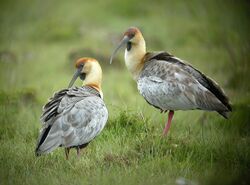Biology:Theristicus
From HandWiki
Short description: Genus of birds
| Theristicus | |
|---|---|

| |
| Black-faced ibis. | |
| Scientific classification | |
| Domain: | Eukaryota |
| Kingdom: | Animalia |
| Phylum: | Chordata |
| Class: | Aves |
| Order: | Pelecaniformes |
| Family: | Threskiornithidae |
| Subfamily: | Threskiornithinae |
| Genus: | Theristicus Wagler, 1832 |
| Type species | |
| Tantalus melanopis Gmelin, 1789
| |
Theristicus is a genus of birds in the family Threskiornithidae. They are found in open, grassy habitats in South America. All have a long, decurved dark bill, relatively short reddish legs that do not extend beyond the tail in flight (unlike e.g. Eudocimus and Plegadis), and at least the back is grey.
Taxonomy
The genus Theristicus was erected by the German naturalist Johann Georg Wagler in 1832 with the black-faced ibis as the type species.[1][2] The name is from the Ancient Greek theristikos meaning "of reaping".[3] The genus contains four species.[4]
| Image | Scientific name | Common Name | Distribution |
|---|---|---|---|
 |
Theristicus caerulescens | Plumbeous ibis | south-western Brazil, especially in southern Mato Grosso and Rio Grande do Sul; Paraguay, especially in the Chaco and in the Paraguayan section of the Parana Basin; Uruguay; north-eastern Argentina and northern and eastern Bolivia |
 |
Theristicus caudatus | Buff-necked ibis | northern and central South America in Colombia, Venezuela, the Guianas and Brazil |
 |
Theristicus melanopis | Black-faced ibis | central Argentina and Chile |
 |
Theristicus branickii | Andean ibis | western South America |
References
- ↑ Wagler, Johann Georg (1832). "Neue Sippen und Gattungen der Säugthiere und Vögel" (in German, Latin). Isis von Oken: cols 1218–1235 [1231]. https://biodiversitylibrary.org/page/26455535.
- ↑ Mayr, Ernst; Cottrell, G. William, eds (1979). Check-list of Birds of the World. 1 (2nd ed.). Cambridge, Massachusetts: Museum of Comparative Zoology. p. 258. https://biodiversitylibrary.org/page/16108898.
- ↑ Jobling, James A. (2010). The Helm Dictionary of Scientific Bird Names. London: Christopher Helm. p. 384. ISBN 978-1-4081-2501-4. https://archive.org/details/Helm_Dictionary_of_Scientific_Bird_Names_by_James_A._Jobling.
- ↑ Gill, Frank; Donsker, David; Rasmussen, Pamela, eds (August 2022). "Ibis, spoonbills, herons, Hamerkop, Shoebill, pelicans". IOC World Bird List Version 12.2. International Ornithologists' Union. https://www.worldbirdnames.org/bow/pelicans/.
- Matheu, E., & J. del Hoyo (1992). Family Threskiornithidae (Ibises and Spoonbills). pp. 472–506 in: del Hoyo, J., A. Elliott, & J. Sargatal (editors). Handbook of the Birds of the World. Vol. 1. Ostrich to Ducks. Lynx Edicions, Barcelona. ISBN:84-87334-10-5
Wikidata ☰ Q763601 entry
 |

